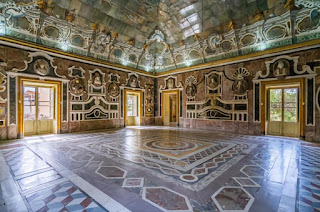Bagheria, comune in provincia di Palermo, lega il suo
toponimo al punico bayharia, cioè
«zona che discende verso il mare», oppure dall’arabo البحرية trascritto baḥriyya, col significato di
«lato mare/marina». Secondo altre ipotesi meno plausibili, invece, deriverebbe
dall’arabo bāb al-gerib, «porta del
vento»; è una delle mete consigliate ai nostri turisti quando ci chiedono la
zona occidentale della Sicilia.
Bagheria è il titolo del romanzo più autobiografico di
Dacia
Maraini, che la vede davvero “allo specchio”, dove si racconta a pieno,
parlando della sua infanzia narrando della sua Sicilia in maniera aperta e
quasi catartica.
Bagheria, o meglio Baarìa, è la nota pellicola di Giuseppe Tornatore del
2009, con la splendida colonna sonora del Maestro Ennio Morricone, che gi
valse il David di Donatello. Il film racconta la vita di una famiglia del
comune di Bagheria attraverso tre generazioni la cui vita si intreccia con gli eventi
storici del Paese.
Meta irrinunciabile per gli amanti delle opere di Renato Guttuso, ospita su tre piani di Villa Cattolica, il Museo inaugurato nel 1973 che ospita le opere donate dal maestro alla sua città natale.
Altra tappa di notevole valore della città di Bagheria
è la visita ad una bottega del carretto siciliano, un tempo mezzo di
trasporto, oggi rivive grazie ad uno dei
maestri più amati Michele Ducato,
uno degli ultimi eredi di un’antica e celebre dinastia bagherese di un mestiere
ormai in via d’estinzione: “Il pittore di carretti” che fin dall’età dei 5
anni, con il pennellino tra le piccole dita sotto l’occhio attento di papà
Peppino, dipingeva quello che Renato Guttuso, definiva il “simbolo
della fantasia, della fierezza, della vitalità del popolo siciliano”.
Ma Bagheria è soprattutto, a mio avviso, andare in
cerca delle tracce degli Alliata, dei Valguarnera, dei Branciforti, dei Gravina,
dei principi di Cattolica nelle loro maestose ville.
Villa Butera, La Certosa, Villa Cattolica- sede del Museo di Guttuso, Villa Trabia, Villa Ramacca, Villa Valguarnera, Villa Galletti Inguaggiato, una delle ville settecentesche meglio conservate della città di Bagheria, Villa San Cataldo ed il suo giardino, Villa Villarosa, Villa Sant’Isiodoro da Cordoba, Villa Spedalotto, Villa San Marco, e l’immancabile Villa Palagonia, detta anche Villa dei Mostri.
Tra le leggende che avvolgono la celebre “Villa dei
Mostri” di Bagheria, innumerevoli
sono quelle che riguardano i due cosiddetti “pupi” in cui ci si imbatte subito prima di entrare dal maestoso cancello,
divenuto l’attuale via di accesso. L’originario ingresso era in realtà sul lato
opposto, quello settentrionale, dove un arco immetteva ad un lungo viale
popolato da quelle sculture grottesche che abbiamo visto nella ricostruzione di
Baarìa.
Tra le fantasiose leggende che avvolgono la villa, i mostri e il loro
negromante committente, ci sono le dicerie, secondo le quali le donne in
gravidanza non dovessero volgere lo sguardo a quelle figure per non incorrere
nel rischio che il nascituro ne potesse riportare le sembianze!
Tutti concordano, che si tratta di leggende, poiché nulla
di documentato con certezza ci giunge né da Francesco Ferdinando Gravina e
Alliata, VII Principe di Palagonia, committente a partire dal 1749 dei corpi
bassi della villa, insieme a questo popolo di personaggi insoliti, né dai suoi
contemporanei.
Il mistero che avvolge la villa ne regala un maggiore fascino ed i due Pupi, fanno parte ormai del modo di dire dei bagheresi che identificano la staticità di alcuni individui che proprio a “palaunia”, sulla piazza antistante la Villa dei Mostri, come le due sculture, stanno lì ad osservare il lento scorrere delle giornate o, stanno a guardare il “passío”, l’andirivieni della gente ed i loro discorsi a volte futili, a volte pieni di saggezza.
Ma Bagheria è anche cucina palermitana tra succulenti piatti tramandati ed il famoso sfincione bianco, un prodotto da forno tipico, di cui ne esistono due versioni, una con sola tuma, formaggio pecorino tipico della cucina siciliana e l’altra prevede anche la ricotta, cipolla, mollica condita con formaggio.












